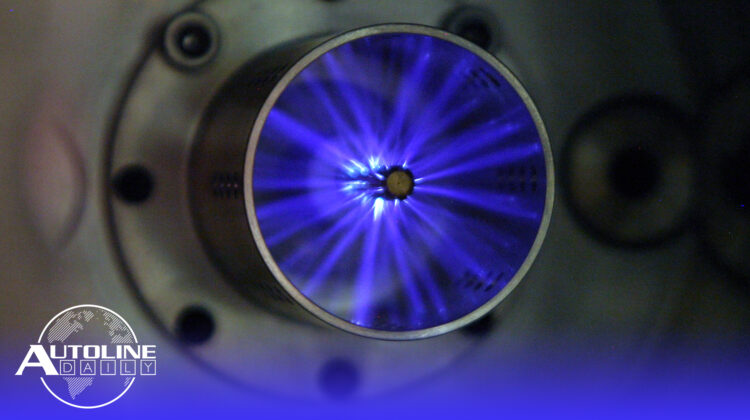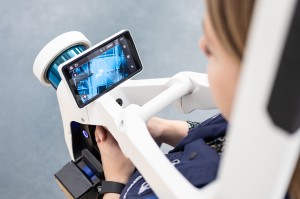

Follow us on social media:
Runtime: 9:54
0:07 BrightDrop Makes 1st Deliveries to FedEx
0:40 Daimler Using LFP Batteries for Long Haul Truck
1:14 Honda Breaks Ground on New EV Plant in China
1:48 VW Test Helps Increase Renewable Energy Use
3:19 EV Production Updates
3:56 BMW Digitizing All of Its Production Plants
4:29 GM Drops 4-Year Degree Requirement for Salaried Workers
5:10 Ford Tries Direct Sales in China
6:39 Plasma Ignition Proves Better Than Spark Plugs
7:54 R.I.P. Maryann Keller
Visit our sponsors to thank them for their support of Autoline Daily: Bridgestone, Intrepid Control Systems, MEDC and Schaeffler.
This is Autoline Daily, the show dedicated to enthusiasts of the global automotive industry.
BRIGHTDROP MAKES 1ST DELIVERIES TO FEDEX
BrightDrop, GM’s electric commercial van service, delivered the first 150 of its Zevo 600 vehicles to FedEx. BrightDrop will supply FedEx with 2,500 vans over the next couple of years. The van is designed for last-mile delivery and has an estimated range of 250 miles. By 2040, FedEx plans to convert its entire fleet to electric and to help support all those EVs it started to build a charging network at its facilities across the country.
DAIMLER USING LFP BATTERIES FOR LONG HAUL TRUCK
Speaking of electric commercial vehicles, Daimler Truck will soon unveil the LongHaul version of its electric Actros truck. It features an LFP or lithium iron phosphate battery pack that’s estimated to return 500 kilometers or 310 miles of range. LFP batteries tend to have a longer life and Daimler claims the eActros LongHaul will be able to charge from 20 to 80% in “well under 30 minutes.” Customer trials start next year.
HONDA BREAKS GROUND ON NEW EV PLANT IN CHINA
Honda is greatly expanding its EV production capacity in China. It broke ground on a new EV production plant with joint venture partner GAC. The plant will make its e:N series of vehicles, like the SUV we showed off yesterday. It’s expected to be online by 2024, which is the same time another plant will open with its other JV partner Dongfeng. Those two plants will have a combined annual production capacity of 240,000 units.
VW WANTS MORE EVs CHARGED WITH RENEWABLE ENERGY
More renewable energy, like wind and solar, can help offset the demand the growing number of electric vehicles will put on the grid, but in Germany, around 6,200 GWh of green electricity had to be switched off in 2020 due to the limited capacity of its power system. That would be enough energy to drive around 2.6 million EVs for a whole year. So, VW wants to tap into that. It’s now testing a pilot program in Germany with about 20 ID owners that will plug into an app when they plan to charge their vehicle next. Based on that info, a charging plan will be determined so the most amount of renewable energy is used. This helps ensure it doesn’t go to waste and more green electricity is used. VW says there will also be financial incentives, like free public charging.
EV PRODUCTION UPDATES
We’ve got a few updates on the start of production for a couple of upcoming electric vehicles. According to AutoForecast Solutions, production of the Genesis GV70 kicks off in the U.S. in December at Hyundai’s plant in Montgomery, Alabama. Production of the next-generation GV70 starts in January of 2028 at Hyundai’s new $5.5 billion EV plant in Georgia that it announced last month. And production of the Ram 1500 BEV begins at Stellantis’ Warren Truck plant in Michigan in November of 2024.
BMW 3D SCANNING ALL OF ITS PLANTS
Assembly plants are complicated and changing one over for a new vehicle can seem like a herculean task. That’s why BMW is taking 3D scans of all of its production sites. By moving the layout of its plants into the virtual world it will more easily be able to plan and make changes for future vehicle programs. It will also greatly cut down on the time needed to do this. By early 2023 BMW says it will have digital scans of all of its plants.
GM DROPS 4-YEAR DEGREE FOR SALARIES WORKERS
In an effort to broaden its talent pool of potential hires, General Motors is dropping its four-year college degree requirement for salaried workers. Instead, the automaker will focus on real-world experience for certain roles and has started a new approach for hiring. It includes a focus on diversity, inclusion and equity as well as on workplace innovation. The effort is part of GM CEO Mary Barra’s goal of becoming the most inclusive company in the world. Nearly half of the 500 new employees it has hired in recent months come from “underrepresented categories” in the auto industry.
FORD TRIES DIRECT SALES IN CHINA
China has big import tariffs on American-made vehicles and that’s reflected in the price of the 2022 Ford F-150 Raptor. The performance truck just went on sale in China with a starting price of just over $102,500. For comparison, the Raptor sells for just shy of $70-grand in the U.S. But even at that price, we bet Chinese consumers will be happy to snap them up. This will also be the first time Ford tests out a direct-to-consumer sales model. So, no need to go through a dealer.
PLASMA IGNITION BETTER THAN SPARK PLUGS
Longtime Autoline viewers may remember a company we talked to a few years back called Transient Plasma Systems. Its developed a plasma ignition system to replace spark plugs, which uses fast pulses of plasma, an electrically charged gas, at a low temperature to ignite the fuel. It improves thermal efficiency and the whole process requires less energy and provides better emissions. And now the company is sharing validation results conducted by the FEV Group. It tested the plasma ignition system in a Toyota 2.5L four-cylinder engine with direct and port injection, which is commonly used in Camry’s, and compared that to the stock ignition. The results show a brake-specific fuel consumption improvement of 6% with the plasma system. That’s the rate of fuel consumption divided by the power produced. And there was no degradation of combustion with increased exhaust gas recirculation and the plasma ignition showed an improved tolerance to lean burn than the stock one. The system could improve fuel economy by as much as 20%.
R.I.P. MARYANN KELLER
A sad note here. Maryann Keller, one of the best known analysts on Wall Street, died last week. Maryann made her name in the auto industry as a Wall Street analyst at Kidder Peabody when in 1979 she predicted that Chrysler was going to go bankrupt. No one believed her and she was roundly ridiculed until Chrysler’s CEO Lee Iacocca finally admitted that the company was out of cash and needed a bailout from the government. She was the first woman to win the title of Institutional Investor’s Top Analyst award, and went on to win it for 12 years in a row. She wrote several books and her first, called Rude Awakening: The Rise, Fall and Struggle To Recover At General Motors, won the prestigious Eccles Prize from Columbia University. She was also a guest a number of times on Autoline. Maryann Keller probably had more influence on the auto industry than any other Wall Street analyst and the industry owes her a debt of gratitude.
Do car designers really need to use clay models to design new cars, or can they do it all digitally? That’s the topic on Autoline After Hours this Thursday. The designer John Manoogian will be joining us, and so will Doug Grieg, the CEO of a company called Tarus that makes clay milling machines. So join John and Gary as they dive into one of the most controversial topics in today’s automotive design.
But that wraps up today’s show, thanks for watching.
Thanks to our partner for embedding Autoline Daily on its website: WardsAuto.com
Seamus and Sean McElroy cover the latest news in the automotive industry for Autoline Daily.








